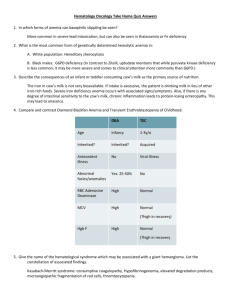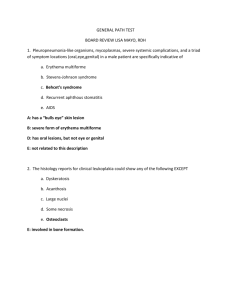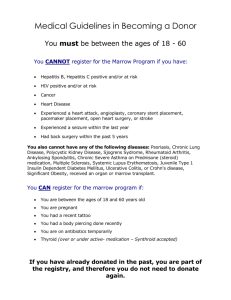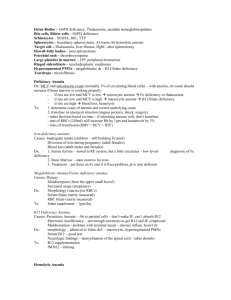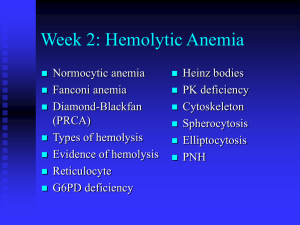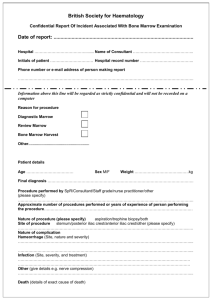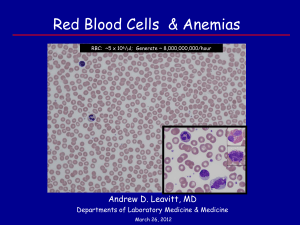Heme Study Guide
advertisement
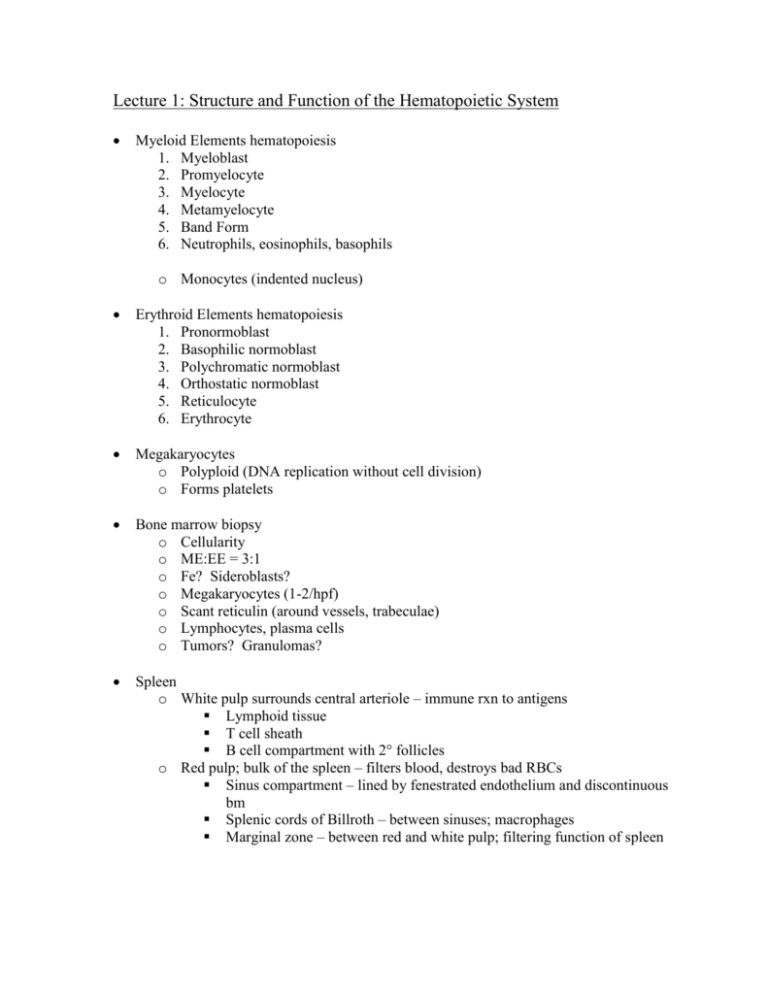
Lecture 1: Structure and Function of the Hematopoietic System Myeloid Elements hematopoiesis 1. Myeloblast 2. Promyelocyte 3. Myelocyte 4. Metamyelocyte 5. Band Form 6. Neutrophils, eosinophils, basophils o Monocytes (indented nucleus) Erythroid Elements hematopoiesis 1. Pronormoblast 2. Basophilic normoblast 3. Polychromatic normoblast 4. Orthostatic normoblast 5. Reticulocyte 6. Erythrocyte Megakaryocytes o Polyploid (DNA replication without cell division) o Forms platelets Bone marrow biopsy o Cellularity o ME:EE = 3:1 o Fe? Sideroblasts? o Megakaryocytes (1-2/hpf) o Scant reticulin (around vessels, trabeculae) o Lymphocytes, plasma cells o Tumors? Granulomas? Spleen o White pulp surrounds central arteriole – immune rxn to antigens Lymphoid tissue T cell sheath B cell compartment with 2° follicles o Red pulp; bulk of the spleen – filters blood, destroys bad RBCs Sinus compartment – lined by fenestrated endothelium and discontinuous bm Splenic cords of Billroth – between sinuses; macrophages Marginal zone – between red and white pulp; filtering function of spleen Lymph nodes o Cortex: germinal centers (B Cell maturation, CD20+, plasma cells) o Paracortex: T cells o Sinuses are lined by histiocytes; lymph enters via afferents and leaves via efferents. Histiocytes phagocytose and filter the lymph o Increase in size is generally reactive (80% follicular hyperplasia. + Granulomas, toxo, cat scratch disease) o 1° follicle = no germinal center; 2° = germinal center o Fetal nodes = no antigen exposure, no 2° follicles Assessing clonality o B Cells: κ or λ of Ig produced o T Cells: TCR, genes; no good surface Ag Lecture 2: Clinical Disorders of Iron Metabolism Iron Balance o RBCs catabolized → Fe released → transferrin picks up → circulation → bone marrow → Fe endocytosis → DCT1 → Iron to mitochondria → Heme o Transferrin drops Fe off at the cell membrane and is recycled back to the circulation o Ferritin can take up Fe2+ and oxidize it to Fe3+ for storage Fe deficiency → ↑ DCT1 and ↓ Ferritin Iron Absorption o Throughout small intestine, maximal in the duodenum o Non-heme Fe → Fe3+ → reductase → Fe2+ → DMT1 → Enterocyte → Ferroportin → Basal side → Fe2+ → Oxidase → Fe3+ → ferritin transport o Heme Fe → HCP1 → Enterocyte → Ferroportin, etc. o Liver → hepcidin → degrades ferroportin → ↓ Fe absorption Iron Deficiency o Hypochromic Microcytic Anemia; ↑ Transferrin ↓ Fe ↑ TIBC ↓ Ferritin o Koilonychia (spoon nails), mucosal atrophy of tongue and stomach, alopecia, pica, intestional malabsorption o Usually from blood loss o GI tract can increase Fe absorption with increased blood loss. If this isn’t enough, the liver can mobilize its stores (stage 1 – normal Hb mass, normochromic, normocytic cells but ↓ stores) o If stores become depleted, cells become microcytic. MCHC normal and cells are normochromic (stage 2) o With progressive loss, the Hb falls faster than the MCV, so the MCHC decreases. (stage 3) o With progressive loss, the RBCs become fragmented and severe poikilocytosis (abnormal RBCs). Hypochromic, microcytic. ↓ RBC survival 2° to ↑ hemolysis (stage 4) Anemia of Chronic Inflammatory Diseases o Microcytic and occasionally hypochromic ↓ Fe ↓ TIBC ↑ Ferritin o Abundant stainable iron in macrophages o Decreased iron absorption o Defect in the release of Fe from macrophages during their catabolism o IL6 increases hepcidin synthesis and inhibits ferroportin and, thus, the release of Fe from cells and the absorption of Fe in the intestine o ↓ erythropoietin response/sensitivity Sideroblastic/Iron loading Anemia o Hyperchromic ↑ Fe NL TIBC ↑ Ferritin o Sideroblast – non-heme iron in cytoplasm, usually in mitochondria surrounding the nucleus o Defect in heme synthesis, in any of the 7 steps from Gly + Succinyl CoA → Heme o Congenital Thalassemia - ↓ in globin chain synthesis, excess heme accumulates and inhibits ALA synthetase Familial/Sex-linked – Mut in ALA synthetase plus ↑ absorption of GI heme; accumulations in organs Lead poisoning – inhibits ALA synthetase, ALA dehydrase, heme synthetase. Detect lead in blood Alcoholism inhibits ALA synthetase. Responds to Pyridoxal-5-Pi INH and cycloserine antagonize pyridoxine Hereditary Hemochromatosis o Autosomal recessive disorder that causes ↑ GI iron absorption (no active method to excrete iron) ↑ Transferrin ↑ Ferritin (>300 mg/ml) o Iron accumulates in organs o HFE decreases hepcidin, which leads to no ferroportin degradation and ↑ GI absorption o Tx: weekly phlebotomy to decrease stores, then every 3-4 months Fe/TIBC Ferritin Fe deficiency ↓/↑ ↓ Chronic Disease ↓/↓ ↑ Sideroblastic ↑/NL ↑ Lecture 3: Megaloblastic Anemia Defective and slowed DNA synthesis Vit B12 and Folate are coenzymes in DNA synthesis (not RNA) o Deficiencies → DNA replication and cellular division are slowed, while cytoplasm (RNA and protein) synthesis is normal ↑ amount of DNA/megaloblastic cell o ↑ size of nucleus o ↑ DNA content o Large cytoplasm (normal synthesis here) o Biochemically defective DNA synthesis Bone Marrow o Slowing of the S phase o ↑ intramedullary cell death o Hyperplastic marrow, appears to be wildly proliferating o ↑ Megaloblastic erythroid precursors ↑ nucleus/cytoplasm ratio Basophilic cytoplasm Prominent nucleoli o Nuclear/cytoplasmic dissociation in erythroid and granulocytic precursors o Megakaryocytes have ↑ nuclei and giant platelets Peripheral Blood o Pancytopenia o ↑ variation in size and shape of RBCs Normochromic Macrocytic ↑ MCV If comorbid with thalassemia trait or severe Fe deficiency, MCV will not be elevated Macroovalocytes (oval macrocytes) mixed with tear drops o ↓ reticulocytes o ↑ nucleated RBCs o ↓ platelets o Hypersegmented polys o ↑ auto-hemolysis Other lab findings o ↑ serum Iron o Saturated transferrin o ↑ LDH o ↓ RBC survival o ↓ Haptoglobin (binds free Hb released from RBCs to prevent oxidation) o ↑ methemalbumin PE o o o o o o o Pallor Fatigue SOB Icterus Hepatosplenomegaly Red, beefy, depapillated tongue + B12 deficiency Peripheral neuropathy Ataxia Parasthesia Pathogenesis o Vit B12 Corin ring with Cobalt Absorption Parietal cells secrete Intrinsic Factor and allows B12 to be absorbed in the terminal ileum Carried by transcobalamin Inadequate intake (rare) Body stores last for years Malabsorption Lack of intrinsic factor o Congenital defect in kids o Pernicious anemia, autoimmune in adults Atrophic gastritis Abs to IF, parietal cells o Bacterial overgrowth/fish tapeworm compete for B12 utilization and prevent absorption o Ileal disease or resection o Gasterctomy o Chronic PPIs o Folate No neurological symptoms Absorption in the proximal jejunum Causes Dietary deficiency common cause of megaloblastic anemia Anticonvulsants, barbiturates, metformin, alcohol Dialysis o Neurologic changes Only present in B12 deficiency; inability to synthesize myelin Begin in the peripheral nerves and progress to involve the posterior and lateral columns Variable ∆ms ↑ serum methyl malonic acid and homocysteine o Vascular disease ↑ homocysteine ↑ risk for thrombosis and premature CV disease Dx o o o o o Coalamin assay (α to B12) Folate assay Stomach pH (neutral if pernicious) Anti-IF/parietal cells Abs (pernicious) Schillings test (for B12) Tx o IV B12 QD x 7days then Q30 days o ↑ dose po cobalamin o po Folate (will not tx neurological sx) Lecture 4: Hemolytic Anemia Findings o ↓ RBC survival o ↑ Bilirubin o ↑ LDH o ↓ Haptoglobin o ↑ Reticulocytes (if marrow is normal) Causes o Inherited Membrane Diseases Hereditary spherocytosis Hereditary elliptocytosis/pyropoikilocytosis Enzyme Disorders (leads to methemoglobinemia) G6PD deficiency Pyruvate kinase deficiency Pyrimidine 5’ nucleotidase Acquired Liver/Renal dysfunction RBC membrane o Outer lipid bilayer with proteins Phospholipids + cholesterol (exchanges with plasma cholesterol) o Underlying cytoskeleton Spectrin o Absence of spectrin or other membrane proteins → bilayer destabilization → budding vesicles → pass through spleen/liver → ↑ vesicle loss → ↓ SA/vol ratio → RBC becomes rigid and spherocytic → ↑ splenic trapping and hemolysis Hereditary Spherocytosis o Spherical RBCs on peripheral smear o ↑ in Northern Europe o ↑ Hemolysis o ↑ MCHC (only thing that does this!) o Gallstones, hemolytic/aplastic crises, megaloblastic crisis, CHF, jaundice, anemia, splenomegaly o ↑ osmotic fragility (early lysis with hypotonic solutions) o Defects in ankyrin, band 3, spectrin, protein 4.2 o Tx Splenectomy with prophylaxis for pneumococcus, H. flu, and N. meningitides Hereditary Elliptocytosis/Pyropoikilocytosis o Ellipitical, cigar-shaped RBCs on peripheral smear (~ to thermal burn) o ↑ in African/Mediterranean descent + some malaria resistance o Mechanical weakness of the cytoskeleton due to defects in proteins o Anemia o Abnormal osmotic fragility test o Tx Rarely necessary, but splenectomy can be helpful Acquired membrane defects o Spur cell From liver disease Abnormal lipoproteins ↑ free cholesterol and inserted on RBC membrane, expanding the bilayer, ↑ surface area and targeting of the RBC Splenic trapping, hemolysis o Burr cell From renal insufficiency Uniform projections Normal cholesterol content Enzyme abnormalities o Maintenance of the RBC membrane Glycolytic (Emden-Meyerhof/anaerobic) pathway Aerobic (Hexose monophosphate) pathway o Pyruvate kinase deficiency In glycolysis, PK converts phosphoenol pyruvate to lactate, creating ATP Deficiency leads to ↓ ATP and ↑ hemolysis from birth (variable) Chronic anemia, jaundice, gallstones, moderate splenomegaly o G6PD Deficiency G6PD catalyzes the first step in the generation of NADPH, used to reduce glutathione and therefore, maintain Hb in the soluble form Deficiency leads to ↑ oxidating agents, insoluble Hb, deposits as Heinz bodies and ↑ hemolysis Short acting hemolysis Heinz bodies Some malaria protection Dx Acute hemolysis who may have ingested an oxidant drug o Methylene blue o Fava beans o Primaquine o Naphthalene o Pyrimidine 5’ nucleotidase deficiency Important in cleaving nucleotides → nucleosides (-sides can leave the cell, unlike –tides) Pyrimidine nucleotides can compete with ADP/ATP in the glycolytic pathway This leads to accumulation of intermediates and hemolysis Causes basophilic stippling Lead poisoning also causes this o Methemoglobinemia and cytochrome b5 reductase Hb can only bind O2 when Iron is Fe2+ (ferrous) Methemoglobinemia is when Iron is Fe3+ (ferric) High concentrations (>30%) cause hemolysis due to Hb ppt Can cause hypoxia at tissues Cytochrome b5 reductase transfers e- to to metHb to → Hb Causes of methemoglobinemia Ingestions of large amounts of oxidants Newborn exposure before reducing capacity is developed Tx Methylene blue, which carries e- from NADPH, and can then donate it to metHb Hereditary MetHb Deficiency in Cytochrome b5 reductase gene (homozygosity) Abnormal Hb (HbM), with an AA sub in either the α or β chain o Homozygous HbM is lethal Lecture 5: Immune Mediated Hemolytic Anemia and Thrombocytopenia WAIHA o IgG to an Rh Ag @ 37° C RBC with Abs encounters Fc receptor on macrophages in the spleen RBC loses part of its membrane, becomes spherocyte and hemolysis occurs o Labs Hemolysis ↓ haptoglobin ↓ Hct ↑ Bilirubin ↑ LDH Spherocytes +/- bite cells Coombs test for Ab o Tx Transfusion support Suppression of Ab Prednisone to ↓ regulate the Fc receptors for the IgG Ab IVIG Splenectomy CAIHA o IgM and complement activation/fixation to RBC surface glycoproteins @ 0-4° C Anti-I against adult RBCs Anti-I against fetal or cord RBCs Activates complement cascade; C3 and C4 are targets for receptor mediated immune attack; C9 in membrane causes leakiness and lysis o Chronic Older people associated with a B cell neoplasm o Acute Younger after M. pneumoniae or EBV (mononucleosis) o Sx Dyspnea Fatigue Agglutination/discoloration in the most distal parts of the body Weakness, back pain, dark urine upon cold exposure Can thrombose in the periphery o Labs + Coombs test using anti-C3 (IgM falls off, but complement stays attached) o Tx Keep patient warm Steroids and splenectomy are not effective Paroxysmal Cold Hemoglobinuria o Features of both WAIHA and CAIHA IgG that functions in the cold, against P Ag on RBCs Fixes complement in the periphery o Associations Congenital or 3° syphilis Kids who develop it after a viral infection o Tx Keep patient warm Tranfusion Prednisone Spenectomy not helpful Drug-related hemolysis o Methyldopa – direct Ab induction with hemolysis; similar to WAIHA o Cephalosporins – immune complex deposition on RBC and complement is activated o High dose PCG – drug binds to RBC, Ab binds to Ab. o Tx: Stop drug Immune Thrombocytic Purpura o Autoantibodies against one’s own platelet glycoproteins Platelets coated with Ab are captured by the Fc receptors on macrophages in the spleen and liver o Also, there is an underproduction of platelets o Kids: suddent onset of petechiae/purpura usually following an infectious illness o Adults: Variable presentation; mild brusing – overt bleeding; no viral illness; chronic o PE: petechiae/purpura; splenomegaly or lymphadenopathy is not typical o Examination of the peripheral smear is mandatory Thrombocytopenia Normal platelet size and morphology Normal RBC and WBC counts/morphologies o You should not see these features: Giant platelets RBC abnormalities Leukocytosis/leucopenia o Tx Adults: steroids, IVIG, splenectomy Kids: resolve on its own, IVIG o Pregnancy Late in pregnancy, lower platelet count than gestational thrombocytopenia IgG antiplatelet Abs can cross the placenta and cause thrombocytopenia in the infant Lecture 6: Sickle Cell Disease and other Hemoglobinopathies Sickle cell disease (phenotype) o Sickle cell anemia (homozygous HbS) o HbSC disease (compound heterozygous HbS + HbC) o HbS-thalassemia (compound heterozygous HbS + one thalassemia gene) Pathophysiology o HbS polymerization Glu → Val @ B6, which permits HbS to polymerize when it is deoxygenated Reoxygenation melts polymer, but repeated cycles damage the membrane, releasing radicals and causing them to become sticky. The cell also begins to leak water and K+, increasing HbS concentration and increasing the likelihood of polymerization These sticky cells abnormally interact and damage the endothelium o Membrane damage → ↑ intravascular hemolysis → ↑ Hb in blood → ↓ NO → vasoconstriction o ↑ LDH Clinical o Painful episode Acute excruciating bouts of pain in the chest, abdomen or extremities Require opioids Vasoocclusive o Acute Chest Syndrome and Pulmonary HTN Acute chest syndrome ↑ with vasoocclusion Postoperatively Fever, chest pain, cough, lung infiltrates and hypoxemia Chlamydia Blood transfusion when hypoxia occurs or the infiltrates advance Pulmonary HTN ↑ with hemolysis May or may not result from acute chest syndrome o Osteonecrosis (aseptic necrosis of bone) ↑ with vasoocclusion Heads of femur, humerus Pain, loss of function, hip/shoulder replacement o Stroke Occlusion of large intracranial vessels o Others Renal failure Labs o Blood counts/smears o DNA-based Dx Tx o Transfusion when: blood pooling in spleen and hypovolemic shock B19 parvovirus suspending erythropoiesis causing an aplastic crisis severe acute chest syndrome Chronic transfusions to reduce risk of stroke require Iron chelation o Pain alleviation by opioids (not prn) o ↑ HbF with hydroxyurea HbF inhibits HbS polymerization o Stem cell transplantation – kids HbC, HbE o β-globin gene mutations o HbC only problematic when with HbS o HbE only when with β-thalassemia Lecture 7: The Thalassemias Mutation in the globin gene that leads to decreased or absent globin chain production o Can occur in any of the globin genes, α, adult β, the fetal γ, or the adult δ o α and β are the most common and important o Malaria resistance α-Thalassemias o The α gene cluster is on C16p and is made up of 1 embryonic ζ and 2 α-globin genes (a total of 4 functional genes) These are expressed throughout fetal and adult life o The common mutations are deletions o Silent Carrier Deletion/mutation involving only 1 gene; clinically well Normal Hb, normal MCV o Trait Deletion/mutation involving 2 genes, either in tandem or one on each chromosome; clinically well Normal Hb, microcytosis (ddx: iron deficient anemia) If in tandem + partner with similar change = 25% risk for Hb Barts hydrops fetalis o HbH Disease Deletion/mutation in 3 genes, leading to only 1 normal gene Leads to excess of β-globin genes, which form tetramers called HbH Moderate anemia Marked microcytosis 25% risk in each pregnancy for Hb Barts hydrops fetalis o Hb Barts hydrops fetalis Lacks all α-globin genes Fetuses are severely anemic and usually die in the 2nd trimester or within hours after birth Mom at risk for pre-exclampsia, HTN, hemorrhage, dystocia (difficult delivery) o Labs Microcytosis Normal ferritin Normal HbA2 (no β-thalassemia trait) o Tx HbH disease: preventive and supportive Avoid oxidant drugs Promptly treat infections and other febrile illnesses β-thalassemias o The β-globin gene cluster is on C11p o γ-globin genes are expressed in utero, and switches to β slowly β-globin gene mutations would not interfere with fetal development in utero; their effects usually manifest 6 months after birth o Most mutations are point mutations, deletions are rare o β-thalassemia minor (trait) Heterozygous, clinically well Microcytosis, borderline low Hb o β-thalassemia major Homozygous or compound heterozygous for β-thalassemia mutations Severe anemia, require monthly transfusions o β-thalassemia intermedia Anemic Clinical severity somewhere in-between minor and major o Pathophysiology of thalassemia Imbalance of α and β globin genes, leading to excess of the normally produced one Excess α will form tetramers, damage RBC membranes, cause hemolysis, ineffective erythropoiesis, iron overload, splenomegaly, marrow hyperplasia and osteopenia o Lab Dx Microcytosis, regardless of the Hb level is the most important β-thalassemia ↓ MCV NL ferritin ↑ HbA2 Major o Severe anemia o Marked microcytosis o Anisocytosis (variable RBC size) o Poikilocytosis (abnormal RBC morphology) o Polychromasia (variable Hb content) o Erythroblastosis (blasts in blood) o ↑ HbF o Tx Monthly transfusion in β major Iron overload (cardiac disease), chelation Marrow transplant Hydroxyurea to ↑ HbF Lecture 8: Lymphoma and Lymphoproliferative Disorders Neoplastic transformation of lymphoid cells → malignant lymphomas o Hodgkin’s Reed-Sternberg cell Bi-nucleate cell in inflammatory background o Non-Hodgkin’s B cell lymphomas represent clonal expansions of discrete stages of differentiation of the cell as it progresses from a small round regular B cell to a plasma cell o 80-85% of malignant lymphomas are B cell, the rest are T cell Lecture 9: Hodgkin’s Disease and Non-Hodgkin’s Lymphoma Malignancy of lymphocytes; reside in lymphoid organs rather than in the circulation Most lymphadenopathy is not malignant o Infections o Auto-immune o Immunodeficiency o Drugs Origin o Lymphocytes derive from pluripotential hematopoietic precursors (splits off from myeloid and erythoid precursors early on) CD20 and CD19 are on the major stages of B cells in lymphomas o B cells start in the bone marrow → lymph node/spleen and mature in response to cytokines and Ags binding to their surface Ig Heavy chain → isotype (IgM, IgG, etc.) Variable regions of heavy and light chains → Ag binding site DNA → somatic rearrangements o T cells start in the bone marrow → thymus → education (delete self-reactive clones and expand those that react correctly with self-MHCs) Reponsive to cytokines and engagement of TCRs Clinical o Lymphadenopathy Painless, rubbery, chronic >1 cm are suspicious o +/- hepatosplenomegaly o B symptoms (fever, 10% weight loss, night sweats) Dx and staging o Dx requires histological analysis (biopsy) o Staging requires CT or MRI, plus LP to determine CNS involvememt (if CN signs) o CBC, +/- ↑ LDH (lymphocyte turnover), +/- ↑ LFT (liver involvement) Hodgkin’s vs. Non-Hodgkin’s (quickly) o Hodgkin’s Reed-Sternberg cell Pleiomorphic cellular infiltrate (variable in size/shape) Usually includes T cells and eosinophils +/- fibrosis ↑ with EBV? Cell of origin probably B cells Excellent cure rate o Non-Hodgkin’s Monomorphic lymphoid infiltrate of B or T cells (85% B cells) Clonal lymphocytes DDx from reactive lymphocytosis ↑ with age OK cure rate Non-Hodgkin’s Pathogenesis o Lymphocytes have ↑ somatic mutation → ↑ likelihood of other chromosomal rearrangements; can confer a growth advantage → malignancy o Burkitt’s Lymphoma (activation of TFs) t(8;14) translocation Ig heavy chain promoter fused to myc gene → myc overexpression o myc = TF that controls cell growth o Mantle cell Lymphoma (activation of cell cycle machinery) t(11;14) translocation Ig fused to cyclin D1 → cyclin D1 overexpression o Cyclin D1 can rush cells through the cell cycle Hard to Tx – resist apoptosis induced by CT or RT o Over-expression of anti-apoptosis genes t(14;18) translocation Fuses the IgH promoter to bcl-2, an anti-apoptosis gene o Li-Fraumeni Syndrome (p53 mutation) Homozygous -/- for p53 (usually one familial + one acquired) → familial cancers at a young age o Other things Environment Pesticides, Pollutants, Viruses (EBV, HTLV-1, HHV-8) Immunosuppresants + EBV → polyclonal lymphoproliferative disorder → can rapidly evolve to monoclonal B cell lymphoma Hodgkin’s Pathogenesis o Infectious? (↑ in 3rd decade and the elderly; ↑ in Northern climates; ↑ in first bornchildren) o Binucleate Reed-Sternberg cell Clonally rearranged Ig genes, but does not express CD19 or CD20 o Pleiomorphic infiltrate of reactive T cells, eosinophils recruited by tumor cells → cytokines Ann Arbor staging of Hodgkin’s Lymphoma o I = one lymph node group 90% young people cured; radiation o II = two or more lymph node group on same side of the diaphragm 90% young people cured; radiation o III = both sides of diaphragm Chemo o IV = disseminated or visceral disease Chemo Revised European-American Lymphoma classification of non-Hodgkin’s lymphoma o Low Grade Incurable with standard Tx; (t(14;18) translocation makes it hard for CT/RT to work) o Intermediate Grade Potential to be cured; CT o High Grade Burkitt’s (myc overexpression) is rapidly fatal; can be cured Lecture 10: B Cell Chronic Lymphocytic Leukemia B-CLL is the most common type of leukemia Dx o Lymphocytosis o Bone marrow involvement of >30% o <55% atypical/immature lymphoid cells in peripheral blood o Low density of surface IgM or IgG with clonal expansion of κ or λ light chains o Characteristic CD5+ CD19+ CD23+ CD10 CD5 is usually on T cells DDx o AML – Blasts o CML – Full spectrum of myeloid development o ALL – Blasts o Hairy cell Leukemia – B cell malignancy with CD5- CD20+ CD11c+ CD103+ CLL Pathophysiology o Disease of small, round, mature B cells; cannot be distinguished from normal lymphocytes on peripheral smear o Distinctive CD5+ CD19+ CD23+ CD10o Monoclonal light chain (κ or λ) Benign lymphocytosis is polyclonal that expresses both κ and λ o Variable molecular basis Deletions at 13q14 is the most common event Prognosis o Varies from months → decades o Rai Stage Stage 0 (only lymphocytosis) → good survival + anemia, thrombocytopenia, lymphadenopathy, hepatosplenomegaly → worse survival o ↑ somatic hypermutation of Ig variable region → good prognosis o Short lymphocyte doubling time → worse prognosis o If the only change is a deletion at 13q14 → good prognosis o CD38 expression → poor prognosis o ZAP-70 (Tyr kinase) Disease Complications o Infections are the leading cause of death (prophylaxis) o Autoimmune disease (causes 14% of WAIHA), but not those Igs produced by the clone itself – polyclonal and derived from other cells o Richter’s Syndrome – 2° more aggressive lymphoid malignancy ↑ LDH, fever, wt loss, lymphadenopathy Med survival = 8 months; resistant to Tx Tx o Some patients never require Tx o Alkylators (cyclophosphamide, chlorambucil) o Adenosine analogs (Fludarabine) [in combination with alkylators] Highly toxic to T cells; contributes to immunodeficiency o Antibody therapy in combination with glucocorticoids Control autoimmune manifestations o Marrow transplantation Risk of GVHD Lecture 11: Myeloproliferative Disorders First question in proliferative disorders o Primary Polycythemia Vera Essential Thrombocytosis CML Myelofibrosis with myeloid metaplasia o Secondary (reactive) Tissue hypoxia Inappropriate erythropoietin Polycythemia Vera o Clonal Disorder o 90% have mutations in JAK2 → ↑ Tyr kinase → ↑ proliferation o Clinical (benign if controlled with Tx) Hyperviscosity Hemorrhage Thrombosis Pruritis, especially after bathing Wt loss Splenomegaly Gout Peptic ulceration Fe deficiency o Lab ↑ RBC mass Thrombocytosis ↑ Histamine ↑ serum B12 Panhyperplasia in the marrow ↓ serum Fe o Tx Phlebotomy Chemo Essential thrombocytosis (clonal stem cell disorder) o Platelet count > 600,000/μL o No known reactive cause (e.g.: Fe deficiency, chronic inflammation/infection, drugs, asplenic states, malignancy, hemorrhage, exercise, chronic hemolysis) o Normal RBC mass o Stainable Fe in the marrow o Absence of the Philadelphia chromosome o 50% have mutations in JAK2 → ↑ Tyr kinase → ↑ proliferation o Clinical >50% asymptomatic o Lab o Tx Hemorrhage Thrombosis (not associated with platelet count or function) Splenomegaly Spontaneous abortions Platelet count > 600,000/μL Large platelets Abnormally clustered megakaryocytes in the marrow ↑ LDH ↓ ESR ↓ CRP None if asymptomatic If Hx of thrombosis, ↑ CV risk factors, pre-operative Chronic Myeloid Leukemia o Stem cell disorder o All myeloid elements involved (+/- B cell involvement) o Philadelphia chromosome + t(9:22) translocation Bcr/abl ↑ Tyr kinase activity → ↑ proliferation o Without Tx, it will → acute leukemia → death o Average age = 45 years; younger than Phil- MPDs o Clinical Stable Asymptomatic or B symptoms Accelerated Phase Clinical o B symptoms o Splenomegaly o Bone pain Lab o Anemia o Thrombocytopenia o Left shift o ↑ blasts o Marrow fibrosis Blast crisis Blasts > 20% o Tx Bone marrow allo-transplant Risk of GVHD Tyr kinase inhibitor Chemo Interferon Myelofibrosis with Myeloid Metaplasia o Chronic MPD Extramedullary hematopoiesis Hepatosplenomegaly Hepatic HTN Leukoerythroblasic smear Nucleated RBCs Polychromatophilia Teardrop cells Early WBC forms Marrow Dry tap; ↑ fibrosis replacing hematopoiesis o DDx “Burned out” P-vera or ET CML Metastatic solid tumors Granulomatous disease Hairy cell leukemia o Clinical Hemorrhage Thrombosis Abdominal pain/distension from organomegaly and ascites o Tx Chemo Thalidomide Splenectomy Supportive Lecture 12: Acute Myelogenous Leukemia Abnormal maturation arrest → accumulation of immature cells Myeloid progenitors can become: o Granulocytes o Erythrocytes o Monocytes o Platelets o Macrophages Eitiology o Unclear o Environmental toxins (radiation, benzene) o Down’s syndrome o Fanconi’s Anemia o 2° leukemia after Tx with an alkylating agent for an unrelated malignancy o After Tx with topoisomerase II inhibitors Clinical o Older people o Bleeding o Bruising o Infection o Fatigue o Organ dysfunction 2° to leukostasis Difficulty thinking Blurry vision Chest pain SOB Kidney/liver failure o DIC o Tumor lysis ↑ WBC count → begin Tx → WBC lysis → cellular contents release → acidosis, renal failure 2° to urate deposition, hyperphosphatemia, hypocalcemia Lab/Dx o Anemia o Thrombocytopenia o ↑ or ↓ WBC count If markedly ↑, leukostasis → organ dysfunction o Marrow Hypercellular ↓ differentiation o Myeloid leukemic blasts in periphery/marrow ↑ nuclear/cytoplasmic ratio ↑ nucleoli Auer rods (immature granules) Pathogenesis o Tranlocations t(8:21); inv 16 and t(15;17) are the most common o >50% of AML cases involve a chromosomal rearrangement Tx o Induction chemo o Risks Cytopenia → ↑ infections Tumor lysis o Older patients Poor performance Poor candidates for induction chemo Case-by-case; need more Tx for the elderly Lecture 13: Acute Lymphoblastic Leukemia Most common leukemia in children o ↑ in boys Also found in adults, but they respond less well to Tx Can relapse to CNS, testes Clinical o Bone pain (limping, inability to bear weight) o Headache o Lymphadenopathy/mediastinal mass o Testicular enlargement o Pancytopenia Evaluation o Marrow biopsy and aspirate o CBC o Serum electrolytes o Urate, LDH, renal function o Lumbar puncture o Immunophenotyping (necessary) TDT+ (precursor B cell) is the most common type Immature lymphocytes with 1-2 nucleoli ↑ nucleus/cytoplasm ratio Prognosis o < 50,000 good o < 2 years old or >10 years old worse prognosis o Old age worse o Females better o Absence of CNS disease good o Precursor B cell ALL better than mature B or T cell ALL o Hyperdiploidy (>50 chromosomes) better o Philadelphia chromosome+ (t(9;22)) worse Tx o Induction chemo o Kids with Philadelphia chromosome+: allogenic marrow transplantation o Adults: allogenic marrow transplantation Lecture 14: Multiple Myeloma Accumulation of neoplastic plasma cells in the marrow Cells produce large amounts of Ig that can be detected in the serum and/or urine o Reciprocal ↓ of other Ig ↑ osteoclast activity 2° to ↑ expression of cytokines → osteolytic lesions Multiple Myeloma is incurable with current standard chemo Complications (from mass effects, cytokines or protein deposition) o Anemia o Osteopenia o Renal failure o Hypercalcemia o Immunodeficiency Dx o Monoclonal plasma cells in the marrow or other sites o Monoclonal Ig in the serum and/or urine o Bone involvement Clinical o Non-specific o Paraprotein (↑ plasma volume, ↓ anion gap [2° to ↑ +M Protein], pseudohyponatremia or pseudohypoglycemia 2° to ↑ water in serum) o Hypercalcemia (mediated by osteoclast activating factor) o Hematologic Rouleaux on smear (roll of coin – pseudomacrocytosis) Anemia Thrombocytopenia M protein coats platelets → dysfunction o Renal insufficiency Light chain deposition → tubular dysfunction Cast nephropathy (light chain ppt, ↓ GFR) Nephrotoxic Abs o Immunodeficiency Effective hypogammaglobulinemia ↓ T and B cell proliferation ↑ infections o Skeletal Punched out bone lesions ↑ fractures o Neurologica Cord compression Neuropathy Tx o Standard Melphalan Prednisone o Complete remissions in ≤ 5% o Interferon o Erythropoetin Improve associated anemia o Novel therapies Thalidomide Create a hostile environment that ↓ the growth of myeloma cells ∆ adhesions molecules and interactions between tumor cells and marrow stromal cells Velcade (Bortezomib) Proteosome inhibitor ↓ growth ↑ apoptosis Overcomes drug resistance Lenalidomide (Revlimid) Analogue of thalidomide Related disorders o Monoclonal Gammopathy of Unknown Significance (MGUS) Serum monoclonal protein (M protwin, IgA, IgG or IgM) at a concentration ≤ 3 g/dL < 10% plasma cells in the marrow No bone lesions, anemia, hypercalcemia or renal insuffiencicy In other words, no organ damage ↑ multiple myeloma development later No evidence for a neoplastic plasma cell proliferative disorder or a B cell lymphoproliferative disorder Asymptomatic The major concern of MGUS is the risk of → symptomatic plasma cell proliferative disorder IgG or IgA MGUS → MM, AL amyloidosis, etc. IgM MGUS → lymphoproliferative disorder (non-Hodgkin’s, CLL, etc.) o AL Amyloidosis β-pleated sheet, Congo red dye, apple green birefringence AL = light chain deposition Non-specific symptoms (weight loss, fatigue, swelling, bleeding, SOB) ↑ involvement of kidneys and heart Nephrotic syndrome Restrictive cardiomyopathy → rapidly progressive heart failure Hepatomegaly, macroglossia, carpal tunnel, etc. Tx: supportive (diuretics, defibrillation, etc.), ↓ underlying plasma cell dyscrasia o Waldenstrom’s Macroglobulinemia Proliferation of intermediate cells between B cells and plasma cells Lymphoplasmacytic infiltrate of the marrow Lymphadenopathy Anemia Neuropathy Organomegaly IgM gammopathy Hyperviscosity syndrome o IgM (pentamer) → blurred vision, fatigue, mucosal bleeding, headache, ∆ mentation o Tx: plasma exchange Tx: alkylating agents (chlorambucil), monoclonal Ab to CD20 (rituximab), nucleoside analogues (fludarabine, cladribine) Lecture 15: Coagulopathies Normal hemostasis o Vascular injury → platelets exposed to subendothelial collagen → 1° plug formation o Reinforced by activation of coagulation and fibrin formation → 2° hemostatic plug o Platelet reactions Adhesion to subendothelial collagen Glycoprotein Ib (platelet receptor) vonWillebrand’s factor o Produced in endothelial cells under autosomal genetic control o Layered on subendothelial collagen o Bridges platelets and collagen, platelet adhestion o Binds and stabilizes inactive factor VIII) Activation Shape change (2b3a receptor forms, binds fibrinogen and forms platelet aggregates) Secretion Depends on o Arachidonate o Thromboxane A2 o Calcium mobilization Aggregation o Coagulation cascade o Coagulation Inhibitors Antithrombin → ↓ Xa and many others Heparin ↑ AT binding to Xa 1000x Protein C → ↓ Va and VIIIa Protein S is a cofactor Tissue Factor Pathway Inhibitor (TFPI) → ↓ Xa, VII o Dx of coagulation disorders Surface bleeds = platelet defects Petechiae Deep tissue bleeds = coagulation defects Ecchymoses Coagulation assays aPTT = Activated Partial Prothrombin Time o Remove TF from plasma sample o Phosopholipid (an activator) and Calcium are added o Measure time until clot forms o Tests intrinsic pathway PT/INR = Prothrombin Time o Add TF and Calcium to plasma sample o Measure time until clot forms o Tests extrinsic pathway Hemophilia (congenital) o ↓ Factor VIII most common (hemophilia A) Normal Factor VIII Accelerates the rate of X → Xa Circulates with vWF Under X chromosome control Disease Normal vWF levels X-linked Severity α levels of ↓ Factor VIII Clinical Spontaneous bleeding into muscles and joints o Repeated bleeding → joint damage and akylosis Mucous membrane bleeding o Tooth extractions o Hematuria o CNS bleeding rare Pain Dx History of a congenital disorder Abnormal aPPT (extrinsic) Normal PT (intrinsic) Normal thrombin time ↓ Hb only duing major hemorrhage Assay for Factor VIII or IX Tx Plasma concentrates of Factor VIII o Risk of Hep, AIDS o Switch to recombinant forms o Risk of Ab to Factor VIII production o ↓ Factor IX Exact same clinical syndrome as ↓ Factor VIII Usually less severe 2/3 of cases have an absolute reduction of factor IX, rather than a reduced functionality X-linked disease Von Willebrand’s disease (congenital) o ↓ vWF activity and 2° ↓ Factor VIII (→ ↑ aPPT) o Autosomal disorder with variable penetrance → ↓ platelet adhesion o Platelet disorder → surface bleeds, petechiae o Dx History Labs Abnormal aPPT Abnormal bleeding time Normal PT Normal thrombin time Normal platelet count o Type I: Absolute reduction in vWF o Type II: Qualitative defect in the polymerization of vWF subunits and loss of function o Tx Less intense than for hemophilia Concentrates of VIII/vWF for serious bleeding DDAVP → ↑ vWF Vitamin K Deficiency (acquired) o ↑ in post-op states with poor nutrition and antibiotics o ↑ PT 2° to ↓ VII (shortest ½ life) Continues with ↓ IX, X, II o Tx: IV or PO Vit K Liver Disease (acquired) o ↑ PT 2° to ↓ VII (shortest ½ life) [prognostic value] o ↓ fibrinogen is a poor prognostic sign o Biliary tract disease → coagulopathy 1/α to Vit-K dependent factors levels Results from impaired Vit K absorption o Portal HTN → hypersplenism → thrombocytopenia o Can cause ↓ or dysfunctional factor synthesis Disseminated Intravascular Coagulation (DIC) o Diffuse hemorrhagic disorder o Pathologic activation of coagulation by some underlying disease o Fibrin clots form → 2° fibrinolysis → ↑ consumption of coagulation factors, platelets, RBCs Factor deficiency (I, II, V, VII, XIII) Thrombocytopenia Excessive fibrinolysis ↑ FDP o Diffuse superficial hemorrhage Ecchymoses Petechiae Oozing from mucous membranes o Dx Variable clinical manifestations IV or SubQ heparin can interrupt the process of factor consumption Other things o Nephrotic syndrome → loss of coagulation factors o Massive blood transfusion → dilution of coagulation factors o Antibodies to coagulation factors or phospholipids (lupus) o Drugs Lecture 16: Thrombotic Disorders and Their Treatment Arterial thrombosis: Hypercoaguable state → atherosclerosis → ↑ shear stress → ↑ platelet activation o White thrombus (platelet rich) Venous thrombosis: Stasis → clotting factors interact → clotting cascade activation o Red thrombus (RBC rich) Tx o Arterial Inhibit Thromboxane (NSAIDS, ASA) Inhibit ADP (Clopidogrel) Gp Ib-IX and GP IIb-IIIa receptor antagonists o Venous Heparin o Both Prevention Warfarin Hypercoagulable states o Antithrombin Deficiency (Autosomal dominant) Most severe form of inherited hypercoagulable states Antithrombin forms a complex with thrombin and prevents the activation of fibrinogen (↑ in the presence of heparin) Tx: Heparin, warfarin o Protein C Deficiency (Autosomal dominant) Protein C is a Vit K dependent protein; activated by thrombin Inhibits factors Va and VIIIa Tx: Warfarin ↑ warfarin induced skin necrosis o Protein S Deficiency (Autosomal dominant) Protein S is a Vit K dependent protein; cofactor to Protein C Tx: Warfarin ↑ warfarin induced skin necrosis o Activated Protein C Resistance (Arg506 → Gln) AA substitution on Factor Va (Factor VLeidin) This Va is resistant to Protein C Tx: Heparin followed by Warfarin o Prothrombin Gene Mutation (G20210A) ↑ prothrombin activity → venous thrombosis o Dysfibrinogenemias Fibrinogen resistant to plasmin digestion o Homocysteine ↑ atherosclerosis, thrombosis 2° to endothelial cell damage Tx: folate Lecture 17: Platelet Disorders Thrombotic Thrombocytopenia Purpura o Immune-mediated platelet destruction o ↑ aggregation of platelets, coagulation o Since ↓ platelets available, ↑ purpura o Sx Thrombocytopenia Hemolytic anemia Renal failure Normal PT, aPPT (unlike DIC)
